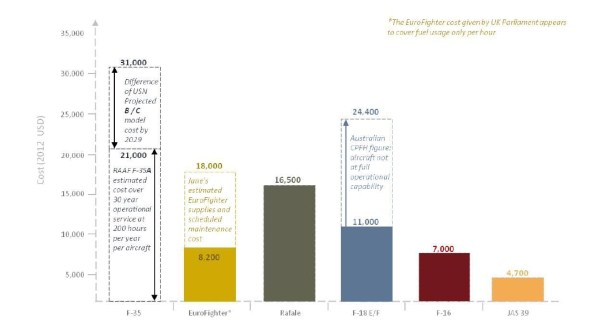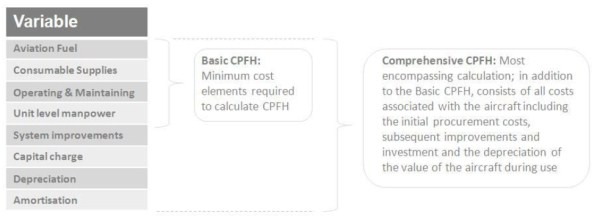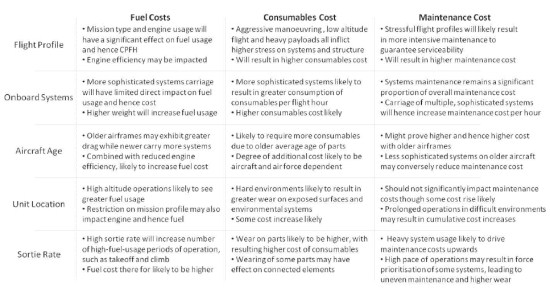
Posted on 07/04/2012 1:01:35 AM PDT by sukhoi-30mki
Gripen operational cost lowest of all western fighters: Jane’s
The study conducted by IHS Jane's Aerospace and Defense Consulting, compared the operational costs of the Gripen, Lockheed Martin F-16, Boeing F/A-18 Super Hornet, Dassault’s Rafale, Eurofighter Typhoon and the F-35 aircraft.

The operational cost of the Swedish Saab Gripen aircraft is the lowest among a flightline of modern fighters, confirmed a White Paper submitted by the respected international defense publishing group IHS Jane’s, in response to a study commissioned by Saab.
The paper says that in terms of ‘fuel used, pre-flight preparation and repair, and scheduled airfield-level maintenance together with associated personnel costs’, “The Saab Gripen is the least expensive of the aircraft under study in terms of cost per flight hour (CPFH).”
The study, conducted by Edward Hunt, Senior Consultant, at IHS Jane’s Aerospace and Defense Consulting, compared the operational costs of the Gripen, Lockheed Martin F-16, Boeing F/A-18 Super Hornet, Dassault’s Rafale, Eurofighter Typhoon and the F-35 aircraft.
“At an estimated $4,700 per hour (2012 USD), the Gripen compares very favorably with the Block 40 / 50 F-16s which are its closest competitor at an estimated $7,000 per hour,” says the report, adding, “The F-35 and twin-engined designs are all significantly more expensive per flight hour owing to their larger size, heavier fuel usage and increased number of airframe and systems parts to be maintained and repaired. IHS Jane’s believes that aircraft unit cost and size is therefore roughly indicative of comparative CPFH.”
In comparison, the figure for the F/A-18 Super Hornet ranged from USD 11000 to USD 24000, depending on degree of operational capability. The figure for the Rafale was USD 16500 per flying hour and number for the Eurofighter Typhoon, derived from British Parliamentary figures and seeming to cover only fuel usage, was USD 8200. But Jane’s estimate of the actual Cost Per Flying Hour for the Eurofighter, keeping in mind supplies and scheduled maintenance raised the figure up to USD 18000.
The cost of operation of the F-35 appears to be in a whole other league. Jane’s cites Royal Australian Air Force (RAAF) estimates for the conventional F-35 A, assuming operational service over 30 years with 200 hours per year for each aircraft, to amount to USD 21000 per hour of flight. The paper also sources US Navy projections of the cost of operation of the F-35 B & C variants until the year 2029, which come to USD 31000 per flight hour.
The report says the figures were based on data sourced from the respective operating militaries and governments, disclosed international fighter competition cost figures (Rafale, F-18 E / F, Gripen), manufacturer-stated figures (F-35, Rafale, F-18 E / F, Gripen) and IHS Jane’s estimates for all aircraft.
There are several caveats to this assessment. “Owing to the differing methods of calculating aircraft operating cost per flight hour and the large number of interlinked factors that affect such a calculation, IHS Jane’s believes that any flight hour cost figure can only be regarded as indicative and that there is no single correct answer to such a calculation,” says the report, but adds, “However, we believe that our results are of considerable merit and provide a useful benchmark when considering the costs associated with operating contemporary high performance combat aircraft.”
The report stresses that ‘without access to comprehensive military data over a significant timeframe’ the results ‘can only be regarded as approximate’ and ‘are an average cost across an entire fleet’.
The report says it is most confident about the data and its conclusions on the Gripen, F-16 and the F/A-18 ‘with good primary and secondary source data supported by logical results from our deductive modeling.’
The numbers for the Eurofighter Typhoon and the Rafale are less certain, in comparison, but the report submits that ‘the comparative modeling output appears to confirm IHS Jane’s estimates’ for them.
The report is least sure about the operational cost of the F-35 costs ‘owing to the absence of actual in-service data’. “IHS Jane’s does not feel that the modeled fuel cost figure is representative of likely CPFH costs,” it says.
Besides using primary and secondary sources and their own databases, IHS Jane’s also considered data thrown up by a ‘modelled assessment of relative cost based on fuel usage’. In the absence of a single global standard for calculating cost per flight hour IHS Jane’s arrived upon a list of factors which would determine this cost.

The study took into account, what it called, Basic cost calculations to the exclusion of a set of factors it grouped under the term, Comprehensive cost calculations, to arrive at a figure determined only by the characteristics of individual aircraft rather than complexity of operations, weapons or support elements.
The study ‘determined that the Basic CPFH was the more common value stated and that this was therefore regarded as a more accurate and useful indication of the cost of sortie generation for a particular aircraft’.
The other factors, under the Comprehensive cost calculations, were ‘more usually considered as part of the platform’s capital cost rather than the daily service cost of which the Basic CPFH was felt to be a more useful representation’.

For the purpose of modeling to create a standard or benchmark, the study arrived at the ‘aircrafts’ fuel usage, hence cost, based on a theoretical one hour sortie at max dry thrust’, not ‘necessarily reflective of actual fuel consumption and hence fuel cost of a one hour sortie’.
As is evident, the modeled cost pattern is closest to the derived cost pattern in the case of the Gripen, F-16, Rafale, and Eurofighter. The research and the model digress in the case of the F-35 and the F/A-18.
In the case of the F-35, the study says the different ‘costs arise from the differing power and specific fuel consumptions of the A / C and B models. The B model is the top figure in both cases’. The study says, “The single P&W F-135 engine is relatively fuel efficient for its power, resulting in a lower fuel burn at maximum dry thrust than might be expected.” It adds that, although obviously, ‘accurate CPFH for in-service aircraft does not exist’, ‘the US and Australian forecast costs both suggest it will not offer lower CPFH than current aircraft’, considering ‘the aircraft itself is an extremely sophisticated design carrying a large number of new and unproven onboard systems’.
The report thinks the digression with respect to the Super Hornet is ‘due to the size of the fleet and the experience the US Navy has in operating’ it, compared to the ‘small fleet of the Royal Australian Air Force (RAAF) that has yet to reach Full Operational Capability’. It points out that ‘RAAF CPFH has fallen significantly as familiarity with the aircraft has grown, and is likely to fall further as this continues to improve’.
But the report also says the Super Hornet has ‘relatively high dry thrust ratings while the GE F414 engine is less efficient in specific fuel consumption than the engines of the similar-sized Rafale and EuroFighter aircraft’. And everything else being the same, the F/A-18 E/F ‘engines use more fuel and are hence relatively costly’ compared to the SNECMA or Eurojet engines, even though the US Navy aircraft have a relatively low CPFH.
On the basis of a 2005 US Air Force study of its F-16 fleet, IHS Jane’s thinks the CPFH is composed of approximately:
– 10-15% Consumable Supplies (small parts, wiring, basic electrical components)
– 20-25% Sortie Aviation Fuel
– 60-70% Depot Level Repair and Systems Maintenance

The study also points to less quantifiable and more intangible factors that could impact CPFH.

Do these figures take into account whether the aircraft in question are actually being used in combat or just training?
I imagine the running costs are significantly less if your aircraft all stay at home and no-one shoots at them and I can’t recall the Gripen being used in anger by any of its’ current users, unlike the F16, F18 and Typhoon.
Beautiful aircraft!
I’m sure Sopwith Camels would be even cheaper to run...
(Probably has the radar cross-section of Los Angeles International Airport.)
“I’m sure Sopwith Camels would be even cheaper to run...”
And more fun. . . .
“And more fun. . . .”
Specially when they catch on fire. :)
ROFLMAO!
Good one, Sir!
The close-engagement dogfight would be based on the skill of the pilot or controller for prop-drones. I suppose that this is romanticizing war but...
But the air combat sims (games) are more engrossing with WWI or II aircraft than fast-movers.
Well, a jet fighter has been shot down by a prop-driven aircraft - a Royal Navy pilot in the Korean war downed himself a MIG, Lt. Peter Carmichael of 802 NAS on 9th August, 1952 who was flying from H.M.S. Ocean.
On the whole I can’t see the flyboys giving up their jets any day soon!
Actually it has far less RCS then the F-15, F-16 or the F-18.
Apples and oranges comparison.
I like the Gripen, a lot, but it’s more accurately described as the natural successor to the F-5 series rather than a competitor to much larger fighters (like the F-35, Rafale, Typhoon and Superbug) or the increasingly long-in-the-tooth F-16.
It might be able to ‘take it on’ in the sense that a Gloster Gladiator could take on a BF-109, but what are its odds?
Your analogy is WAY off. I would actually give the Gripen excellent odds. The Eurofighter is an expensive piece of junk. Its not like it has a huge advantage over the Gripen. The Swiss trials and Indian trials have actually proven the Eurofighter to be a mere paper Tiger. The Gripen isnt really the best of the lot either but at least it makes a lot more economic sense.
Save for the F-22, the Gripen probably has the smallest RCS among ALL other fighters currently in service. Exactly how many stealth fighters are in service around the world currently?
Really? Most of the sources I have read have said that the Gripen is outclassed in pretty much every category except cost with the Eurofighter.
I can certainly agree that the Eurofighter project has been ruinously expensive and undercapable for the cost, but for all that, it is still a better plane than the Gripen.
As I alluded to, a Gripen might get lucky in the hands of a skilled pilot, just as the Gloster Gladiator won air battles on occasion over ostensibly more advanced German aircraft, but all other things being equal, the Eurofighter is going to win.
And the Gloster Gladiator is biplane totally different category. That comparison isn't even a valid one. Gripen and Eurofighter are both 4+ generation fighters. Both are canard and delta winged, low observable modern fighters but neither of them are stealth. Both have very good aerial kinematics, AESA radar, advanced avionics, senors, long range BVR weapon suite and standoff range weapon. Both will be seeing each other about the same time. As to who will win an aerial engagement will depend on the overall dynamics of the situation. But to say all things being equal Eurofighter will always win is just silly fan boy enthusiasm. Eurofighter really has nothing that gives it an overwhelming tactical edge against the Gripen.
Besides one-to-one marginal difference matters very little into overall strategic calculation. The ability to pack more punch with fewer dollars is a much more important consideration. And that is where the Gripen punches holes inside the overpriced and under-performing Eurofighter.
Disclaimer: Opinions posted on Free Republic are those of the individual posters and do not necessarily represent the opinion of Free Republic or its management. All materials posted herein are protected by copyright law and the exemption for fair use of copyrighted works.